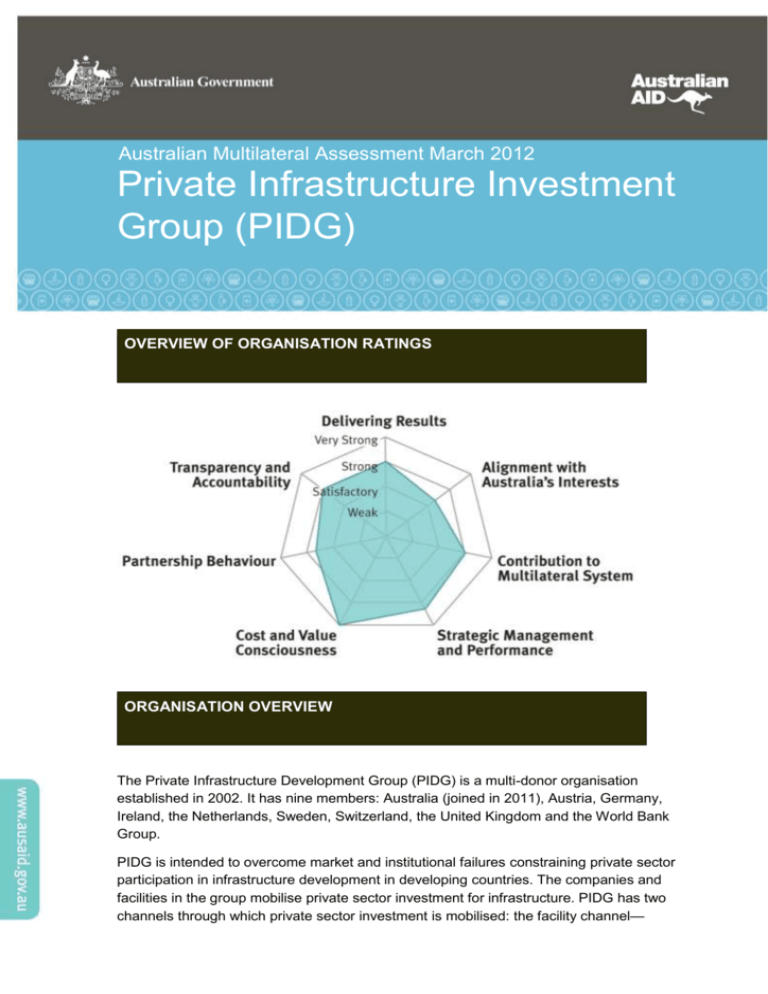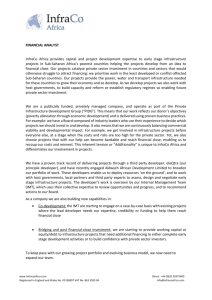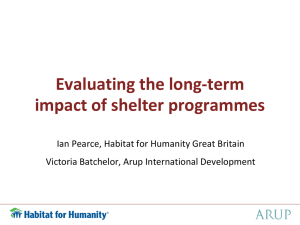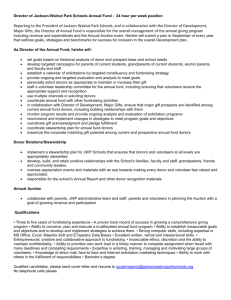Report
advertisement

1 Australian Multilateral Assessment March 2012 Private Infrastructure Investment Group (PIDG) OVERVIEW OF ORGANISATION RATINGS ORGANISATION OVERVIEW The Private Infrastructure Development Group (PIDG) is a multi-donor organisation established in 2002. It has nine members: Australia (joined in 2011), Austria, Germany, Ireland, the Netherlands, Sweden, Switzerland, the United Kingdom and the World Bank Group. PIDG is intended to overcome market and institutional failures constraining private sector participation in infrastructure development in developing countries. The companies and facilities in the group mobilise private sector investment for infrastructure. PIDG has two channels through which private sector investment is mobilised: the facility channel— commercial and development financial institutions provide financing to PIDG vehicles alongside equity from PIDG members (through a trust); and the project channel—private sector investment alongside the investment of PIDG vehicles. As Australia only recently became a member of PIDG, Australia did not provide any contributions in 2010–11. PIDG is intended to overcome market and institutional failures constraining private sector participation in infrastructure development in developing countries. The companies and facilities in the group mobilise private sector investment (PSI) for infrastructure. PIDG has two channels through which PSI is mobilised: the facility channel—commercial and development financial institutions provide financing to PIDG vehicles alongside equity from PIDG members (through a trust); and the project channel—private sector investment alongside the investment of PIDG vehicles. In the order of their formation, the PIDG companies and vehicles are: > the Emerging Africa Infrastructure Fund Ltd (EAIF), which provides long-term hard currency loans to private sector infrastructure projects in the least developed and other low income countries in Sub-Saharan Africa (excluding South Africa), where risks are perceived as unacceptably high by commercial lending institutions > DevCo, which is a transaction advisory facility within the International Finance Corporation, supporting governments in least developed countries, other low income countries and lower middle income countries and territories in the preparation and structuring of infrastructure projects for private sector investment > Technical Assistance Facility (TAF), which provides grant funding for local capacity building in association with the PIDG companies and DevCo > GuarantCo Ltd, which provides guarantees for local currency investment in infrastructure projects in Sub-Saharan Africa (excluding South Africa) and Asia > InfraCo Ltd (InfraCo Africa), which acts as a principal developer, assuming the upfront costs and risks associated with early-stage project development, and thereby reducing entry costs for investors > InfraCo Asia Development Pty Ltd (InfraCo Asia), launched on the model of InfraCo Africa to develop greenfield infrastructure projects in Asia, and > Infrastructure Crisis Facility–Debt Pool LLP (ICF-DP), which provides financing alongside development finance institutions (DFIs) to unlock private sector infrastructure projects in developing countries which had stalled in the recent debt crisis. As of June 2011, PIDG members had disbursed US$456 million to PIDG companies and facilities. This has been used to support 99 projects and 45 grants in 45 countries. Of these projects, 62 per cent were in Sub-Saharan Africa and 27 per cent in the AsiaPacific region. 2 RESULTS AND RELEVANCE 1. Delivering results on poverty and sustainable development in line with mandate STRONG PIDG attracts private investment into infrastructure projects that have identifiable and substantial development benefits. It operates as a lean organisation but catalyses very large private investments in frontier areas of infrastructure. From PIDG’s start in 2002 to August 2011, projects that had reached financial closure involved private sector investment commitments of US$15.9 billion from the US$456 million investment by PIDG donors. These projects are expected to provide new and improved infrastructure services to almost 140 million people. PIDG has a results-based system of monitoring at facility and project levels. Projects that have been physically built and that are actually delivering services on the ground (typically two to three years after financial close) are monitored for impacts to ensure private sector investment and development targets are being delivered. Both ex-ante and ex-post development impact indicators are monitored, updated and published by PIDG’s Program Management Unit. Most of PIDG’s work, in terms of project numbers and values, has been in low income countries and focused on under-served areas and populations. The nature of the work results in services being provided or improved for those who have not had access in the past. a) Demonstrates development or humanitarian results consistent with mandate STRONG PIDG makes an important contribution to attracting private investment into infrastructure projects which have identifiable and substantial development benefits. It operates on a small scale, but with the aim of catalysing further private investments in frontier areas of infrastructure. From PIDG’s start in 2002 to 31 August 2011, its projects which have reached financial close have involved private sector investment commitments of US$15.9 billion. These projects are expected to provide new and improved infrastructure services to almost 140 million people. PIDG projects have mainly been in energy and telecoms; recently its priorities within the energy sector have shifted to renewables. It has decided to move on from pioneering in mobile telecoms to the provision of telecoms/internet related supporting infrastructure. Its portfolio also includes projects in transport, water and agribusiness. 3 Flagship projects which PIDG has helped, or is helping, include: > the Kalangala Infrastructure Services project in Uganda, which provides clean water, solar powered energy and transport access to a previously unserved, isolated and poor rural community > the Olkaria project in Kenya, which will produce geothermal power for more than one million people, many in rural areas > the Seacom undersea fibre optics cable project, which will be the first provider of high bandwidth in East Africa > a project in Chad bringing communications to previously unserved areas, and > an investment in Liberia’s power sector, which will increase electricity generation from little more than 2MW to up to 20MW, enabling transmission to currently unserved areas. Since this total of commitments results from investment by the PIDG donors of US$456m, PIDG observes that every US$1 of PIDG donor funding has helped deliver almost US$35 of investment commitments in infrastructure in developing countries. The Australian Multilateral Assessment notes, however, that approximately 28 per cent of this US$15.9 billion has been co-funding from official development finance institutions (DFIs), and their participation may share the credit for attracting private investors. PIDG includes in the measured benefits of its projects not only the numbers of people served by new or rehabilitated infrastructure, but also the fees which private operators pay to government authorities (typically as franchise fees), and what it estimates are the public subsidies avoided by putting infrastructure in private hands, as well as jobs generated by the projects during construction and operation. It estimates that its projects which have reached financial close will generate US$3.6 billion in upfront fees, plus US$1.3 billion in avoided subsidies. It states that these projects are expected to lead to almost 74 000 short-term jobs during their construction phase, and over 170 000 long-term jobs during their implementation phase, along with a significant number of indirect jobs created through multiplier effects. There are ongoing questions about the scope and method of PIDG’s benefit measurement regarding the accuracy of reported figures. These issues are being resolved in collaboration with the DFI indicator harmonisation working group convened by the International Finance Corporation and comprised of approximately 12 member development finance institutions/multilateral development banks (including PIDG). 4 b) Plays critical role in improving aid effectiveness through results monitoring STRONG PIDG has a results-based system of monitoring at both program and project-levels. Moreover, given its objective of attracting private investment, investor responses provide PIDG with continuous feedback on results. At program-level, all PIDG companies and facilities are required to submit an annual business plan which includes a full logframe; and at each of the twice-yearly PIDG meetings, they report progress against the logframe targets, while the program management unit (the group secretariat) is required to report progress against the overarching PIDG logframe. At the project-level, once a project has been approved for development or financing by a PIDG company or facility, a standard results monitoring sheet is completed, setting out details of expected outputs and outcomes against an agreed list of development impact indicators for the PIDG (for example, private sector investment attracted, number of people to be provided with services). After project implementation, a project completion report is completed by the program management unit’s development advisor, comparing actual achievement with original expectations and highlighting areas that need to be addressed. Projects that have been physically constructed, are fully operational and are delivering services on the ground are monitored for actual impacts to ensure that private sector investment and developmental targets are being delivered. Both ex-ante and ex-post development impact indicators are monitored, updated and published by the program management unit. c) Where relevant, targets the poorest people and in areas where progress against the MDGs is lagging STRONG At the direction of its donors, most of PIDG’s work, in terms of project numbers and values, has been in low income countries and focused on under-served areas within them. The nature of the work results in services being provided or improved for those who have not had access in the past. As at 31 August 2011, 72 per cent of PIDG projects were in these countries. Its targets for 2010–12 include having at least 75 per cent of the private investment it facilitates in them. Although some PIDG projects are in countries in DAC group III (for example, India), these projects target particularly poor sectors (such as through slum upgrading) or poor regions. 5 2. Alignment with Australia’s aid priorities and national interests SATISFACTORY PIDG contributes to sustainable economic development by increasing opportunities for well-designed public–private partnerships in infrastructure and removes legislative and regulatory impediments to doing business in developing countries. This serves Australia’s broader interests in global and regional economic development. PIDG’s work has a high degree of alignment with the strategic goals of the Australian aid program in the areas of sustainable economic development and effective governance through improved governance, provision of jobs, infrastructure and services and improved market operations. PIDG does not systematically capture information on or report on crosscutting issues (such as gender or disability) in its work or systematically analyse the implications of its work on these issues. However, two studies aimed at improving the disaggregation of gender related data by the PIDG Facilities and improved understanding of the links between infrastructure investment and its impact on women and girls have been commissioned by the PIDG program management unit (one in collaboration with the International Finance Corporation) and are currently underway. PIDG’s objectives include promoting private investment in infrastructure in post-conflict states and around 20 per cent of its activities to date have been in fragile states. PIDG is investigating ways to increase the amount of work it undertakes in fragile and postconflict countries. a) Allocates resources and delivers results in support of, and responsive to, Australia’s development objectives STRONG PIDG contributes to sustainable economic development by increasing opportunities for well-designed public–private partnerships in infrastructure and removes legislative and regulatory impediments to doing business in developing countries. This serves Australia’s broader interests in global and regional economic development. PIDG has been responsive during several years to Australian interest in the design and operation of its companies and facilities, especially InfraCo Asia. The recently commissioned gender studies by the PIDG program management unit are also partly in response to Australia’s aid priorities. 6 b) Effectively targets development concerns and promotes issues consistent with Australian priorities STRONG There are strong links between the strategic goals of the Australian aid program and the work undertaken by PIDG. This is seen particularly in the areas of sustainable economic development and effective governance through improved governance, provision of jobs, infrastructure and services and improved market operations. Since the expansion or improvement of infrastructure in low income countries improves their prospects of attaining the MDGs, PIDG activities are well aligned with Australian development objectives. c) Focuses on crosscutting issues, particularly gender, environment and people with disabilities WEAK PIDG applies European Union or World Bank environmental and social standards to its projects. It has recently given priority to renewable energy projects, including: > a geothermal generation project in Kenya > solar power generation on the Kalangala project in Uganda > a project in Solomon Islands for a hydro-electric generating plant to replace diesel generators > a wind-farm project in Cape Verde, and > power generation using methane gas trapped at the bottom of Lake Kivu in Rwanda. In terms of gender, no evidence was found of a formal gender policy at PIDG to either incorporate gender concerns in project design or measurement of impact. However, PIDG is in the process of commissioning two studies to detail how to better assess, record and quantify the impact of PIDG-supported projects on women and girls. PIDG has also pointed out that some of its projects, such as increasing access to piped water and electricity, free up the time of women and girls and allow them to undertake commercial activities and education. It also states that its technical assistance facility program targets gender equality issues in some projects, noting a women’s cooperative established to operate a block manufacturing plant in association with the Calcom cement project, and efforts to ensure that women fully participate in a cooperative formed to manage the Chanyanya irrigation project in Zambia. PIDG does not appear to give specific attention to disability inclusiveness in its projects. 7 d) Performs effectively in fragile states SATISFACTORY PIDG has only recently given explicit attention to working in fragile states, but its objectives include promoting private investment in infrastructure in post-conflict states, as soon as conditions are stable enough for this to be feasible. It has had some successes in this: DevCo has assisted private sector participation in the power sector in Liberia; and a GuarantCo guarantee has helped bring in private investment to the telecommunications sector in the West Bank. In April 2010, DevCo successfully concluded the Haiti Telecom project, representing Haiti’s largest foreign direct investment following the earthquake. There are also projects in Rwanda and Sierra Leone. DevCo has a logframe target for 20 per cent of the private sector investment commitments mobilised by its projects to be in post-conflict countries. The other PIDG facilities are also currently investigating ways of increasing the amount of work they undertake in fragile and post-conflict countries. This was discussed at the November 2011 PIDG donors meetings. 3. Contribution to the wider multilateral development system STRONG PIDG has helped mobilise US$16 billion of public works since 2002. It performs an effective coordinating role between governments, donors and the private sector. It is innovative in its own concept and structure, and in the nature of its facilities. PIDG has filled a critical gap in the development field and has successfully leveraged donor funds to secure significant private sector development in projects and areas that, despite potential, may have been overlooked or neglected by other development mechanisms. The successive formation of companies and facilities in the group reflects a process of close observation of market conditions and readiness to experiment in filling gaps. For example, PIDG responded during the recent financial crisis by creating the innovative Infrastructure Crisis Facility–Debt Pool. This innovative approach is seen as valuable by its stakeholders. 8 a) Plays a critical role at global or national-level in coordinating development or humanitarian efforts STRONG PIDG has demonstrated successes at the global-level by coordinating resources to fund its infrastructure projects. This coordination includes donors, partner governments and private industry. Successful leveraging of donor money has led to PIDG estimating that every US$1 invested by donors has led to US$35 in investment, leading to the mobilisation of US$15.9 billion. A good example of PIDG’s role in coordinating with governments to facilitate a development outcome is seen in PIDG’s work in the Philippines and the provision of electricity to remote islands. PIDG worked with the government to introduce private sector participation in electricity generation through the development of legislation and a new regulatory framework. The success of this program has seen the provision of reliable power to some of the remotest communities and the government is replicating this model in several other industries and locations across the country. b) Plays a leading role in developing norms and standards or in providing large-scale finance or specialist expertise STRONG PIDG has played a leading role in leveraging donor funds to secure significant private sector development in projects and areas that, despite potential, may have been overlooked or neglected by other development mechanisms. An increasing focus for PIDG is its work in encouraging investment in renewable energy infrastructure. c) Fills a policy or knowledge gap or develops innovative approaches STRONG PIDG is innovative in its own concept and structure, and in the nature of its facilities. The successive formation of companies and facilities in PIDG reflects a process of close observation of market conditions and readiness to experiment in filling gaps. The organisation’s willingness to use financing and project development mechanisms that are not widely applied by other donors is a strength. It responded during the recent financial crisis with the further innovation of the Infrastructure Crisis Facility–Debt Pool. This innovative approach is seen as valuable by stakeholders. 9 ORGANISATIONAL BEHAVIOUR 4. Strategic management and performance STRONG PIDG’s clear strategy is set out in its constitution. Beneath this is a set of operating principles effectively carried through into resource and program management. There is a clear line from its constitution through to planning, monitoring and delivering operations. PIDG’s management model is drawn from the private sector. Each corporate entity has a board with professional expertise which contracts through tender for management of the facility according to stated objectives. This model effectively keeps all PIDG companies and facilities focused on applying the operating priorities and policies determined by donor members. It maintains control over all operational aspects. PIDG’s organisation-wide framework for monitoring and evaluation projects is sound. Evaluation reports (and other information) are used to reassess and adapt the operation of its companies and facilities. Human resources management practices include rigorous merit-based appointment and promotion and substantial performance incentives. a) Has clear mandate, strategy and plans effectively implemented STRONG PIDG’s clear strategy is set out in its constitution. Beneath this is a set of operating principles effectively carried through into resource and program management. There is a clear line from its constitution through to planning, monitoring and delivering operations. The overarching strategy and policy for PIDG as a whole and its components is the responsibility of the PIDG donors. The group has been designed, however, so that decision making in program and project development is allocated to those best equipped for this, while adhering to the strategy and policy decided at group-level. b) Governing body is effective in guiding management VERY STRONG PIDG has an unusual model, drawn from the private sector, of having for each corporate entity a board with professional expertise which contracts through tender for management of the facility according to stated sets of objectives. This model is effective in keeping all the PIDG companies focused on applying the set of operating priorities and policies determined by its donor members. Some of the oversight mechanisms used by donor members include: 10 > in the case of DevCo and TAF (which are not corporate entities), which mainly provide technical assistance, individual investments are approved on a ‘no objection’ basis by donors > in the investment companies, decisions within agreed investment policies are the responsibility of the boards, which comprise individuals with a mix of banking and development experience, and > project identification and development is the responsibility of Fund Managers selected on a competitive basis from private sector organisations with experience in providing such services in developing country environments. c) Has a sound framework for monitoring and evaluation, and acts promptly to realign or amend programs not delivering results STRONG PIDG has a sound framework for monitoring and evaluation of projects. Benefits from projects are estimated during preparation, and checked or adjusted after project implementation. It is clear that evaluation reports (and other information) are used to reassess and adapt the operation of PIDG companies and facilities. Project completion reports are brought together annually for examination by both facility boards and donors, to enable adjustments to be made to policies, strategies or other arrangements as necessary. Full evaluations are subject to detailed discussion at the twice-yearly meetings of donors, and action is taken to address any identified shortcomings or areas of concern. There is also a system of independent evaluation and review, every three to four years, of each facility in the PIDG group. This is intended to ensure that the facilities and companies (and the central administrative unit) remain effective and relevant, in the context of needs in target country markets for privately operated infrastructure. An independent quality assurance audit of the PIDG’s development impact results is to be undertaken annually. The first of these will commence in January 2012 for which an appropriate service provider is currently being competitively procured. 11 d) Leadership is effective and human resources are well managed STRONG PIDG does well in this respect—because of its clear specification of responsibilities within its companies and facilities, its rigorous use of merit-based appointment and promotion, and its substantial performance incentives. 5. Cost and value consciousness VERY STRONG PIDG companies and facilities continuously strive to control costs and get value for money—their aim is to make profit and they work in a framework of incentives related to that. PIDG states that its annual administration costs are currently 0.5 per cent of disbursed funds under management. Rates of return and cost effectiveness are treated as crucial. Its companies keep control of expenditure through a budget process and audit. All costs are audited annually by external auditors and audit reports forwarded to donors for comment. Full financial details of all of facilities are presented to donors for detailed examination and review. PIDG adheres to European Union/World Bank procurement processes (as relevant) to minimise costs while achieving maximum value for money. All loans and guarantees issued by its facilities are subject to detailed due diligence by relevant managers which ensures the implementing partner has adequately addressed all issues, including value for money. If local partners in developing countries lack experience in how to achieve maximum value for money, PIDG provides grant support through its technical assistance facility to build their capacity. a) Governing body and management regularly scrutinise costs and assess value for money VERY STRONG The boards and managements of the financing facilities in the PIDG group are continuously concerned with controlling costs and achieving value for money, because they have the aim of profitability and work in a framework of incentives related to that. 12 The PIDG companies initially use donor members’ funding for working capital, but their administrative costs are ultimately expected to be met from profits generated by each company. This is already being achieved by the Emerging Africa Infrastructure Fund, and is on the way to being achieved by GuarantCo and InfraCo Africa. PIDG companies keep control of expenditure through a budget process and audit. All PIDG costs are audited annually by external auditors, and the audit reports are forwarded to donors for comment. Full financial details of all PIDG facilities are presented to the donors for detailed examination and review. All PIDG procurement adheres to EU/World Bank procurement processes (as relevant) in order to minimise costs while achieving maximum value for money. Fees paid to non-executive directors are set by donors and reviewed regularly and fund managers, and the central administrative unit, are selected by open, competitive tenders. PIDG has stated that annual administration costs are currently 0.5 per cent of disbursed funds under management. The external reviews of PIDG facilities and the PIDG program have included examinations of cost effectiveness, with positive findings. b) Rates of return and cost effectiveness are important factors in decision making VERY STRONG The financing facilities in the PIDG group are directly and strongly concerned with getting a sufficient return for their financial commitments and related overheads, and focused on containing costs as part of attaining their crucial rate-of-return objectives. In the technical assistance facilities, cost effectiveness is a clear focus of attention. Rates of return and cost effectiveness are treated as crucial. Its companies keep control of expenditure through a budget process and audit. All costs are audited annually by external auditors, and audit reports are forwarded to donors for comment. Full financial details of all of its facilities are presented to donors for detailed examination and review. c) Challenges and supports partners to think about value for money VERY STRONG All loans and guarantees issued by PIDG facilities are subject to detailed due diligence processes by the relevant managers which ensures that the implementing partner has adequately addressed all relevant issues, including value for money. 13 If local partners in developing countries lack experience in ensuring they achieve maximum value for money, PIDG provides grant support through the technical assistance facility to build their capacity. DevCo works closely with government departments in developing countries to ensure that value for money is fully understood and taken into account in reviewing available options. 6. Partnership behaviour STRONG PIDG collaborates constructively with development finance institutions and multilateral banks to fill gaps by identifying and/or preparing projects. It works closely and effectively with other multi-donor facilities, such as the public–private infrastructure advisory facility. PIDG, by definition, works in what developing country governments determine is needed through public–private partnerships in infrastructure. All PIDG supported projects are required to be in line with national government priorities and policies whether they are initiated in direct response to formal requests from governments for assistance or by private sector/commercial developers of infrastructure projects. In the case of a number of transport, energy and water infrastructure activities, PIDG works successfully through partner government systems. PIDG facilities apply the environmental and social standards of the European Union or International Finance Corporation (World Bank) to its projects. PIDG regularly consults with local civil society organisations in designing and implementing activities. a) Works effectively in partnership with others STRONG PIDG fills a gap by identifying or preparing projects for official development financial institutions or multilateral development banks, and in that way collaborates constructively with them. PIDG has links with, and frequently partners at a project level, a number of international financial institutions and regional development banks (for example, World Bank Group, African Development Bank and the Asian Development Bank) as well as with development financial institutions active in the infrastructure sector in target countries. PIDG states that it works closely with other multi-donor facilities in order to ensure good coordination with their activities. PIDG provides a biannual forum for broad donor discussion on strategy and approaches to the encouragement of private sector investment for infrastructure in the poorer developing countries; this forum has been attended not only by PIDG contributing donors, but also by other interested donors and organisations. 14 PIDG appears to have satisfactory relations with private investors including in developing countries, and with project sponsors, many of whom are clients of the PIDG financing and investment facilities. b) Places value on alignment with partner countries’ priorities and systems STRONG PIDG works within whatever developing countries’ governments have determined is the available space for public–private partnerships in infrastructure. Some examples of how PIDG has aligned well with government systems and priorities include: > DevCo projects are initiated in direct response to formal requests from governments for assistance, and therefore are led by the requirements of local governments > TAF responds directly to requests to undertake capacity building programs, in order to improve their ability to undertake infrastructure projects with the private sector, and therefore works closely with them at all times, and > InfraCo Africa works closely with local governments on some projects—for example, the Cabeolica wind farm project in Cape Verde. Periodic reviews of PIDG facilities have elicited favourable feedback from governments in developing countries, to the effect that PIDG facilities are bridging real gaps in the market and helping to leverage private investment in infrastructure. All PIDG supported projects are required to be in line with national government priorities and policies whether they are initiated in direct response to formal requests from governments for assistance or by private sector/commercial developers of infrastructure projects. c) Provides voice for partners and other stakeholders in decision making SATISFACTORY PIDG facilities apply the environmental and social standards of the European Union or International Finance Corporation (World Bank) to its projects. PIDG states that whenever possible and appropriate, it works with local civil society organisations and non-government organisations in order to maximise the pro-poor benefits of projects in which it is involved, citing as examples: > the Kalangala Infrastructure Services project in Uganda, involving meetings with village communities > a cement factory expansion in India in which TAF funded the development of a women’s cooperative for producing concrete blocks, and 15 > the Chanyanya irrigation project in Zambia, in which InfraCo Africa helped villagers form a cooperative to invest in the irrigation company. Because of the small scale on which PIDG operates, as yet there is no independent evidence on the quality of its participatory arrangements. 7. Transparency and accountability STRONG PIDG recently upgraded its group policy on transparency by specifying the types of information it will make publicly available. Its disclosure practice corresponds to the policy and is adequate. It publishes information in conformity with standard commercial practice. PIDG is investigating whether it is appropriate and possible to implement the International Aid Transparency Initiative guidelines on information standardisation. PIDG’s criteria for allocating resources, and its procedures generally, are transparent for its donors and easy enough for other partners to understand and follow. PIDG provides technical assistance where capacity to understand and use systems are insufficient. Very strong systems for financial management, audit, risk management and fraud prevention are in place. Risk management takes the form of policies in investment companies, including for portfolio diversification, and documented, step-wise processes for committing funds on the basis of risk-weighted expectations of adequate returns. PIDG seems generally to promote transparency in its business partners. It is in the process of developing a Code of Conduct, to be adopted by all elements of its structure. Commitment to transparency will be one of the code’s nine elements. a) Routinely publishes comprehensive operational information, subject to justifiable confidentiality STRONG The PIDG group has recently upgraded its policy on transparency by specifying what types of information it will make publicly available. Its disclosure practice corresponds to the policy and is adequate. It publishes information in conformity with standard commercial practice. Audited accounts of the PIDG trust are produced annually and these are distributed to donors for circulation through their systems. Donor contributions are published on the PIDG website and in the annual report, listing the PIDG facilities to which they have contributed. Funding of projects by the PIDG facilities is similarly published on the PIDG website and in the annual report. Each PIDG company produces annual audited accounts. 16 PIDG is currently investigating whether it is appropriate and possible to implement the International Aid Transparency Initiative guidelines on information standardisation. b) Is transparent in resource allocation, budget management and operational planning SATISFACTORY PIDG functions by identifying and developing projects which will satisfy both its stated requirements for development impact and private investors’ requirements for riskweighted returns. In this sense, its principles for allocation of resources are transparent, even though the determination of its investments may be subject to commercial confidentiality until matters are decided or settled. PIDG provides technical assistance where capacity to understand and use systems are insufficient. c) Adheres to high standards of financial management, audit, risk management and fraud prevention VERY STRONG PIDG has very strong systems in this respect. For example: > PIDG, the program management unit and all PIDG companies are subject to annual independent external audits > the boards of PIDG companies have audit committees, and > managers report to the directors of each company, who are in turn responsible for ensuring that investments accord with the investment policy set by donors. Risk management takes the form of policies in the investment companies, including for portfolio diversification, and documented, stepwise processes for committing funds on the basis of risk-weighted expectations of adequate returns. 17 d) Promotes transparency and accountability in partners and recipients STRONG Subject to protecting commercial information, PIDG promotes transparency in its business partners. A PIDG code of conduct is in the process of being developed. one of the nine elements of the code will be a commitment to transparency. The code will be adopted by all elements of the PIDG structure. PIDG is monitoring the construction sector transparency initiative and other transparency initiatives, to ensure that it adheres to best practice. 18









